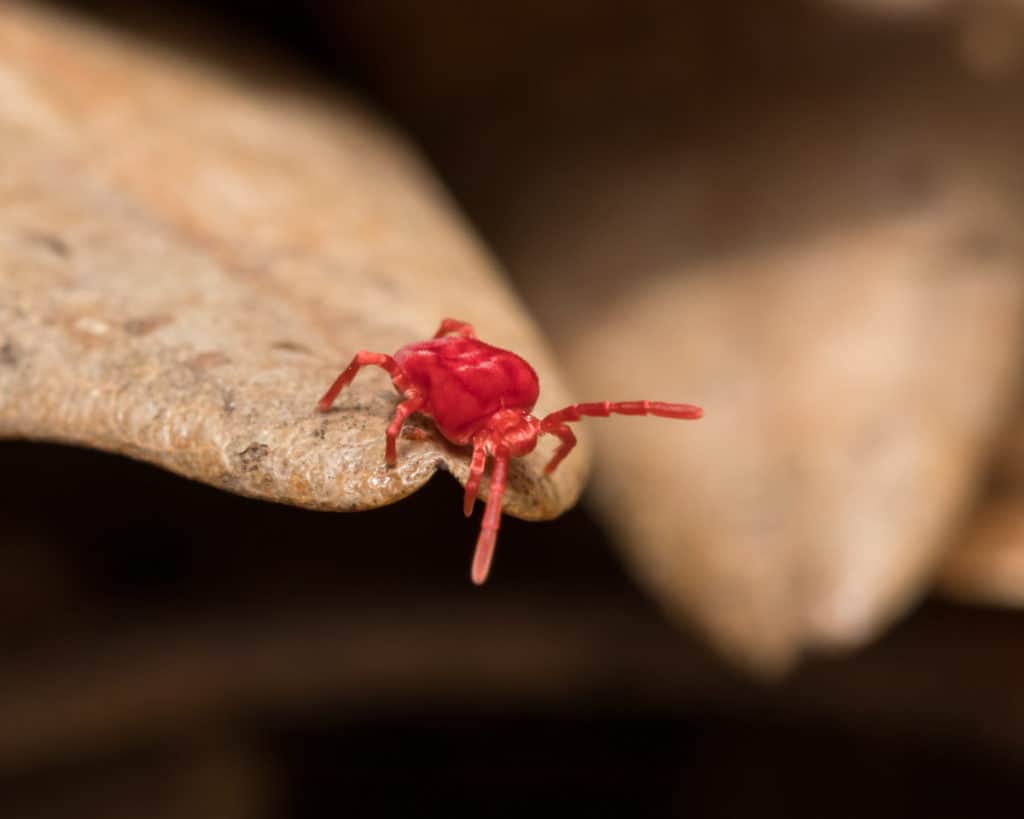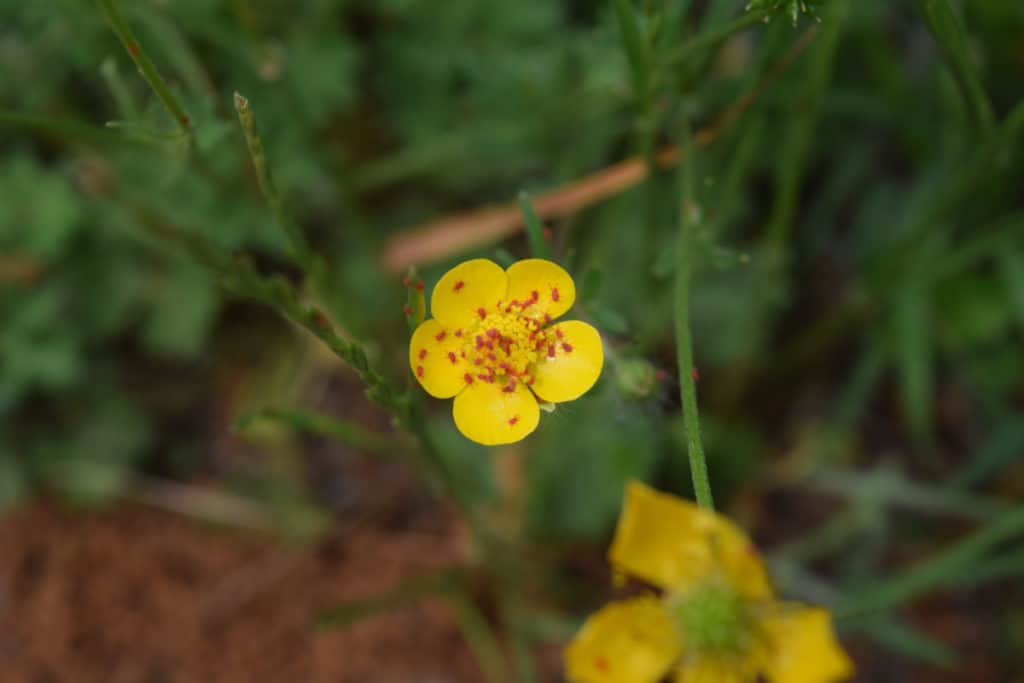Slightly smaller than a pinhead, clover mites are tiny creatures that belong to the arachnid family together with ticks and spiders. They have oval-shaped bodies, and their length ranges from 0.75- 0.85 mm. Found in almost every continent, they are known by other names such as red mites, red clover mites, window mites, velvet mites, and much more. They are one of the top plant-feeding mites and appear in massive numbers.
Clover mites aren’t a threat to human health, pets or cause major damage to household property. They don’t bite or sting, they don’t transmit diseases like other household pests, but they can stain surfaces and fabrics when crushed. They also invade houses in massive numbers, making them a nuisance.
Read on as we uncover how they damage our plants, seasons you are likely to see them, how to identify them, how to get rid of them, and prevent future infestation.
Understanding the Clover Mite
Adult clover mites are greenish or reddish-brown in color, while the young ones and eggs are bright red. Like their arachnid relatives, they have eight legs, the front legs are longer and protrude from their head, making them look like antennae.
The tiny critters reproduce parthenogenetically. Their eggs do not need fertilization by males, and their populations are entirely females. The mites lay about 70 eggs each in dry, protected areas that shield them from the summer heat and the freezing winter temperatures. Due to this mode of reproduction, they multiply quickly and infiltrate homes in thousands.
The overwintering eggs give rise to a spring generation, which goes through summer hibernation by becoming inactive on warm, dry days. On hatching in spring, the larvae start feeding immediately and undergo two nymphal stages before becoming an adult.
Clover mites are sensitive to heat and are destroyed by temperatures above 39 degrees centigrade. They are also stimulated to dormancy under temperatures below 24 degrees. They are active in spring and fall and inactive during winter and summer.
Damage caused by Clover Mites in Homes
Clover mites are not harmful to humans or pets, nor will they destroy furniture, clothing, and food items. However, they invade homes in large numbers and become a bother with their presence. The populations seem to pop up overnight!

They also cause cosmetic damage with their red stains when crushed. The bloodstains they leave make people think they are dealing with blood-sucking insects.
These little creatures can also lodge on rooftops and patios, where they can feed on algae, mildew, or molds. When they invade in large numbers, they cause significant damage to your house plants, ornamental flowers, and lawns. Lush lawns and yards turn into ugly dry patches.
Luckily, they are a temporary nuisance at homes with a lifespan of about a month. They appear and vanish within no time since there is no plant life to feed on in your house. They mainly enter houses with a bushy surrounding and can infiltrate homes through available openings. When grass extends to the foundation of your house, there is an increased probability of the mites invading your home.
How Clover Mites Ruin Your Garden
These little bugs are voracious plant feeders. Shockingly, they feed on more than 200 plant species, including clover, dandelion, strawberry, primrose, salvia, alyssum, and shepherds purse. They use their tiny, specialized piercing mouthparts to break through plant cells and suck up the juices.

These creatures are numerous in lawns with abundant growth of succulent, well-fertilized grass. When they invade in large numbers, they cause small, irregular silver streaks on leaves. Heavily infested yards turn brown while foliage becomes yellow or brown and then wilt.
When are they Likely to Invade Your Home?
Clover mites invade houses mainly during spring but may also appear during cooler months of the year. Unlike other pests, they prefer cooler weather and become more active as temperatures start to drop. Interestingly, cool summers enhance their survival, while dry summers lead to their inactivity or aestivation.
They also become indoor pests in harsh weather conditions such as excessive heat and heavy rains. In the spring season, they are attracted by the growth of lush vegetation around your home perimeter. Fortunately, they do not reproduce while indoors and usually within a few days from dehydration.
When you are on the lookout for clover mites in your house also keep a close eye out for carpet beetles. These guys can cause damage to your property. We have written an article about this it’s called, What Causes Carpet Beetles? What Should You Watch Out For?
How Do You Identify Clover Mites?
Clover mites appear as dark moving spots to the naked eyes as they crawl around walls, doors, windows, furniture, curtains, and drapes. If you observe them with a magnifying glass, you will see their colored bodies, with eight legs in adults and six in larvae. Their front limbs are elongated and extend forward, which makes them look like antennae.
Their outbreak can be mistaken for predatory mites that bear similar behavioral characteristics, body size, and color. Their tiny body size makes it easy to crush them, leaving behind red stains on floors, furniture, walls, curtains, and other personal belongings.
How to Get Rid of Clover Mites from Your House and Garden
Luckily, clover mites are a temporary nuisance in your home and clear within a short time. If the infestation is not too bad, you can wait for the dry summer season for the population to die out on itself. Here are the measures you can take to control if the infestation is intense.
Indoor Mites
Vacuum up Clover Mites
The best and effective way to eradicate clover mites is to suck them up with a vacuum cleaner to avoid crushing the staining of your house and properties. They do not have a good grip and are sucked up efficiently in a vacuum cleaner. Make sure to clean the surrounding walls and windowsills to pick up any mites or eggs that are not easily visible. To avoid further infestation, ensure you seal the vacuum cleaner bag before trashing it away.
Clean Gently With a Wet Sponge
You can use a soapy rag or wet sponge to clean them off from the walls, concrete, tables, and other surfaces. The detergent removes and kills them quickly. The soap scent that is left behind is also an effective repellent to keep the mites off. Ensure you don’t crush them by pressing hard with a sponge since you may end up with a mess of red stains everywhere.
Spray Them with Insecticides
You can spray the clover mites indoors with a safe insecticide such as permethrin, diazinon, chlorpyrifos, or bifenthrin. Insecticides should be used as the last resort since they degrade the quality of air in your home.
Wipe Your Furniture With Detergents Containing Boric Acid
Some laundry detergents like borax contain boric acid, which can help to repel and eradicate the mites. You can also sprinkle powdered detergent on your carpets, pieces of furniture, and rugs.
Leave Out Water on Open Containers
Clover mites will certainly search for water in your house since they are away from their food sources. If you leave a basin full of water, they will find it and fall in and drown.
Clean up Pets Using Soap and Water
If your cats or dogs get infested with clover mites on their fur, clean them thoroughly with water and soap to remove them. You can also use insecticidal soap, which is also safe for pets.
Seek Help from a Pest Control Expert
If clover mite infestation in your house is massive, you may opt to seek a pest control expert who can recommend a safe and effective solution to eliminate the menace.
Outdoor Clover Mites
Spray Individual Plant with Liquid Insecticides
If your trees, lawn, and other plants are infested, spray them with effective insecticides such as malathion or tetramethrin. They should be applied in the morning or late in the evening to prevent the scorching of plants. It is also advisable to follow label instructions to avoid overdosing or under dosing.
Use Strips of Double-Sided Tape
If you notice clover mites near your house, you can lay down strips of double-sided adhesive tape along your exterior walls and in front of openings. As they crawl on the adhesive, they will get stuck and eventually die. Once the adhesive tape gets covered with dead clover mites, discard it and put another strip in place.
Spray the Walls of Your House
You can spray a barrier of exterior control insecticides around the wall of your house and other structures. You may need to repeat the process a couple of times to bring the infestation under control. For best results, spray the walls early in the morning or evening.
Water Dry Areas on Your Lawns
Clover mites like to lay eggs on dry areas of the land like bases of evergreen plants, sun-exposed walls, and cracks on sidewalks. Watering these dry patches will prevent the eggs from hatching. The eggs resemble small, maroon balls.
Prevention Measures
- Remove grass and weeds (18-24 inches) around the foundation perimeter. This is the most effective prevention measure.
- Place a plant-free strip of coarse sand, gravel, Larva rock, marbles, or wood chips around the foundation since it is difficult for clover mites to cross barriers.
- Seal the gaps around doorways, window frames, cracks, and crevices to close potential entry points into your house. You can also apply diatomaceous earth around the entrances to prevent them from accessing your home by dehydrating and killing them.
- Clean litter regularly around your home.
- Plant flowers and shrubs that do not attract clover mites. These include roses, junipers, spruces, geraniums, and yews.
- Avoid over- fertilization of lawns and ornamental plants around your home to prevent the lush growth of host plants that attract clover mites.
- Use weather stripping around the door and windows.
The Wrap Up
Clover mites are very tiny; this makes it easy for them to access your home through small cracks and crevices. Unlike many other household pests, they are not harmful to people, pets, or properties. Their activity starts during early spring when they become a nuisance to homeowners due to their massive populations and the red stains they leave when squashed. They have evolved to shield themselves in summer by hibernating and in winter by overwintering.
Sources
https://www.arrownj.com/should-i-be-concerned-about-clover-mites
https://www.americanpest.net/blog/post/what-to-do-if-clover-mites-invade-your-home-this-winter
https://www.arrownj.com/blog/post/how-to-get-rid-of-clover-mites
https://stoppestinfo.com/410-how-to-get-rid-of-clover-mites.html
https://bugwiz.com/get-rid-of-clover-mites/#What%E2%80%99s_a_clover_mite
